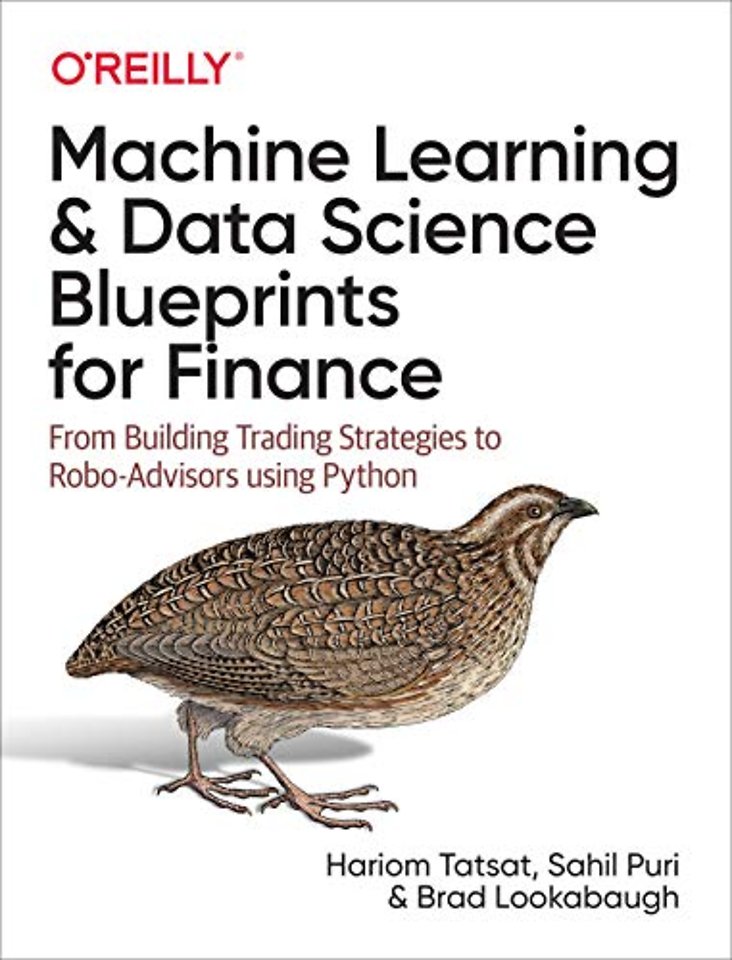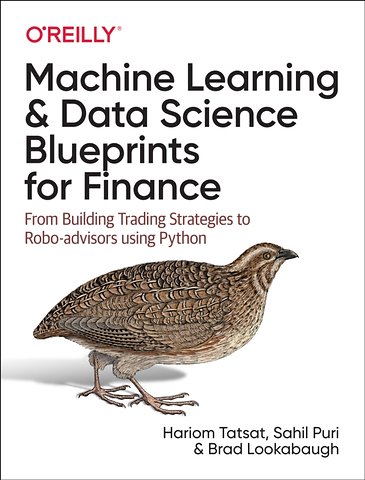Machine Learning and Data Science Blueprints for Finance
From Building Trading Strategies to Robo-Advisors Using Python
Paperback Engels 2021 1e druk 9781492073055Samenvatting
Over the next few decades, machine learning and data science will transform the finance industry. With this practical book, analysts, traders, researchers, and developers will learn how to build machine learning algorithms crucial to the industry. You’ll examine ML concepts and over 20 case studies in supervised, unsupervised, and reinforcement learning, along with natural language processing (NLP).
Ideal for professionals working at hedge funds, investment and retail banks, and fintech firms, this book also delves deep into portfolio management, algorithmic trading, derivative pricing, fraud detection, asset price prediction, sentiment analysis, and chatbot development. You’ll explore real-life problems faced by practitioners and learn scientifically sound solutions supported by code and examples.
This book covers:
- Supervised learning regression-based models for trading strategies, derivative pricing, and portfolio management
- Supervised learning classification-based models for credit default risk prediction, fraud detection, and trading strategies
- Dimensionality reduction techniques with case studies in portfolio management, trading strategy, and yield curve construction
- Algorithms and clustering techniques for finding similar objects, with case studies in trading strategies and portfolio management
- Reinforcement learning models and techniques used for building trading strategies, derivatives hedging, and portfolio management
- NLP techniques using Python libraries such as NLTK and scikit-learn for transforming text into meaningful representations
Specificaties
Lezersrecensies
Inhoudsopgave
Who This Book Is For
How This Book Is Organized
Part I: The Framework
Part II: Supervised Learning
Part III: Unsupervised Learning
Part IV: Reinforcement Learning and Natural Language Processing
Conventions Used in This Book
Using Code Presented in the Book
Python Libraries
O’Reilly Online Learning
How to Contact Us
Acknowledgments
Special Thanks from Hariom
Special Thanks from Sahil
Special Thanks from Brad
I. The Framework
1. Machine Learning in Finance: The Landscape
Current and Future Machine Learning Applications in Finance
Algorithmic Trading
Portfolio Management and Robo-Advisors
Fraud Detection
Loans/Credit Card/Insurance Underwriting
Automation and Chatbots
Risk Management
Asset Price Prediction
Derivative Pricing
Sentiment Analysis
Trade Settlement
Money Laundering
Machine Learning, Deep Learning, Artificial Intelligence, and Data Science
Machine Learning Types
Supervised
Unsupervised
Reinforcement Learning
Natural Language Processing
Chapter Summary
2. Developing a Machine Learning Model in Python
Why Python?
Python Packages for Machine Learning
Python and Package Installation
Steps for Model Development in Python Ecosystem
Model Development Blueprint
Chapter Summary
3. Artificial Neural Networks
ANNs: Architecture, Training, and Hyperparameters
Architecture
Training
Hyperparameters
Creating an Artificial Neural Network Model in Python
Installing Keras and Machine Learning Packages
Running an ANN Model Faster: GPU and Cloud Services
Chapter Summary
II. Supervised Learning
4. Supervised Learning: Models and Concepts
Supervised Learning Models: An Overview
Linear Regression (Ordinary Least Squares)
Regularized Regression
Logistic Regression
Support Vector Machine
K-Nearest Neighbors
Linear Discriminant Analysis
Classification and Regression Trees
Ensemble Models
ANN-Based Models
Model Performance
Overfitting and Underfitting
Cross Validation
Evaluation Metrics
Model Selection
Factors for Model Selection
Model Trade-off
Chapter Summary
5. Supervised Learning: Regression (Including Time Series Models)
Time Series Models
Time Series Breakdown
Autocorrelation and Stationarity
Traditional Time Series Models (Including the ARIMA Model)
Deep Learning Approach to Time Series Modeling
Modifying Time Series Data for Supervised Learning Models
Case Study 1: Stock Price Prediction
Blueprint for Using Supervised Learning Models to Predict a Stock Price
Case Study 2: Derivative Pricing
Blueprint for Developing a Machine Learning Model for Derivative Pricing
Case Study 3: Investor Risk Tolerance and Robo-Advisors
Blueprint for Modeling Investor Risk Tolerance and Enabling a Machine Learning–Based Robo-Advisor
Case Study 4: Yield Curve Prediction
Blueprint for Using Supervised Learning Models to Predict the Yield Curve
Chapter Summary
Exercises
6. Supervised Learning: Classification
Case Study 1: Fraud Detection
Blueprint for Using Classification Models to Determine Whether a Transaction Is Fraudulent
Case Study 2: Loan Default Probability
Blueprint for Creating a Machine Learning Model for Predicting Loan Default Probability
Case Study 3: Bitcoin Trading Strategy
Blueprint for Using Classification-Based Models to Predict Whether to Buy or Sell in the Bitcoin Market
Chapter Summary
Exercises
III. Unsupervised Learning
7. Unsupervised Learning: Dimensionality Reduction
Dimensionality Reduction Techniques
Principal Component Analysis
Kernel Principal Component Analysis
t-distributed Stochastic Neighbor Embedding
Case Study 1: Portfolio Management: Finding an Eigen Portfolio
Blueprint for Using Dimensionality Reduction for Asset Allocation
Case Study 2: Yield Curve Construction and Interest Rate Modeling
Blueprint for Using Dimensionality Reduction to Generate a Yield Curve
Case Study 3: Bitcoin Trading: Enhancing Speed and Accuracy
Blueprint for Using Dimensionality Reduction to Enhance a Trading Strategy
Chapter Summary
Exercises
8. Unsupervised Learning: Clustering
Clustering Techniques
k-means Clustering
Hierarchical Clustering
Affinity Propagation Clustering
Case Study 1: Clustering for Pairs Trading
Blueprint for Using Clustering to Select Pairs
Case Study 2: Portfolio Management: Clustering Investors
Blueprint for Using Clustering for Grouping Investors
Case Study 3: Hierarchical Risk Parity
Blueprint for Using Clustering to Implement Hierarchical Risk Parity
Chapter Summary
Exercises
IV. Reinforcement Learning and Natural Language Processing
9. Reinforcement Learning
Reinforcement Learning—Theory and Concepts
RL Components
RL Modeling Framework
Reinforcement Learning Models
Key Challenges in Reinforcement Learning
Case Study 1: Reinforcement Learning–Based Trading Strategy
Blueprint for Creating a Reinforcement Learning–Based Trading Strategy
Case Study 2: Derivatives Hedging
Blueprint for Implementing a Reinforcement Learning–Based Hedging Strategy
Case Study 3: Portfolio Allocation
Blueprint for Creating a Reinforcement Learning–Based Algorithm for Portfolio Allocation
Chapter Summary
Exercises
10. Natural Language Processing
Natural Language Processing: Python Packages
NLTK
TextBlob
spaCy
Natural Language Processing: Theory and Concepts
1. Preprocessing
2. Feature Representation
3. Inference
Case Study 1: NLP and Sentiment Analysis–Based Trading Strategies
Blueprint for Building a Trading Strategy Based on Sentiment Analysis
Case Study 2: Chatbot Digital Assistant
Blueprint for Creating a Custom Chatbot Using NLP
Case Study 3: Document Summarization
Blueprint for Using NLP for Document Summarization
Chapter Summary
Exercises
Index
Anderen die dit boek kochten, kochten ook
Rubrieken
- advisering
- algemeen management
- coaching en trainen
- communicatie en media
- economie
- financieel management
- inkoop en logistiek
- internet en social media
- it-management / ict
- juridisch
- leiderschap
- marketing
- mens en maatschappij
- non-profit
- ondernemen
- organisatiekunde
- personal finance
- personeelsmanagement
- persoonlijke effectiviteit
- projectmanagement
- psychologie
- reclame en verkoop
- strategisch management
- verandermanagement
- werk en loopbaan







